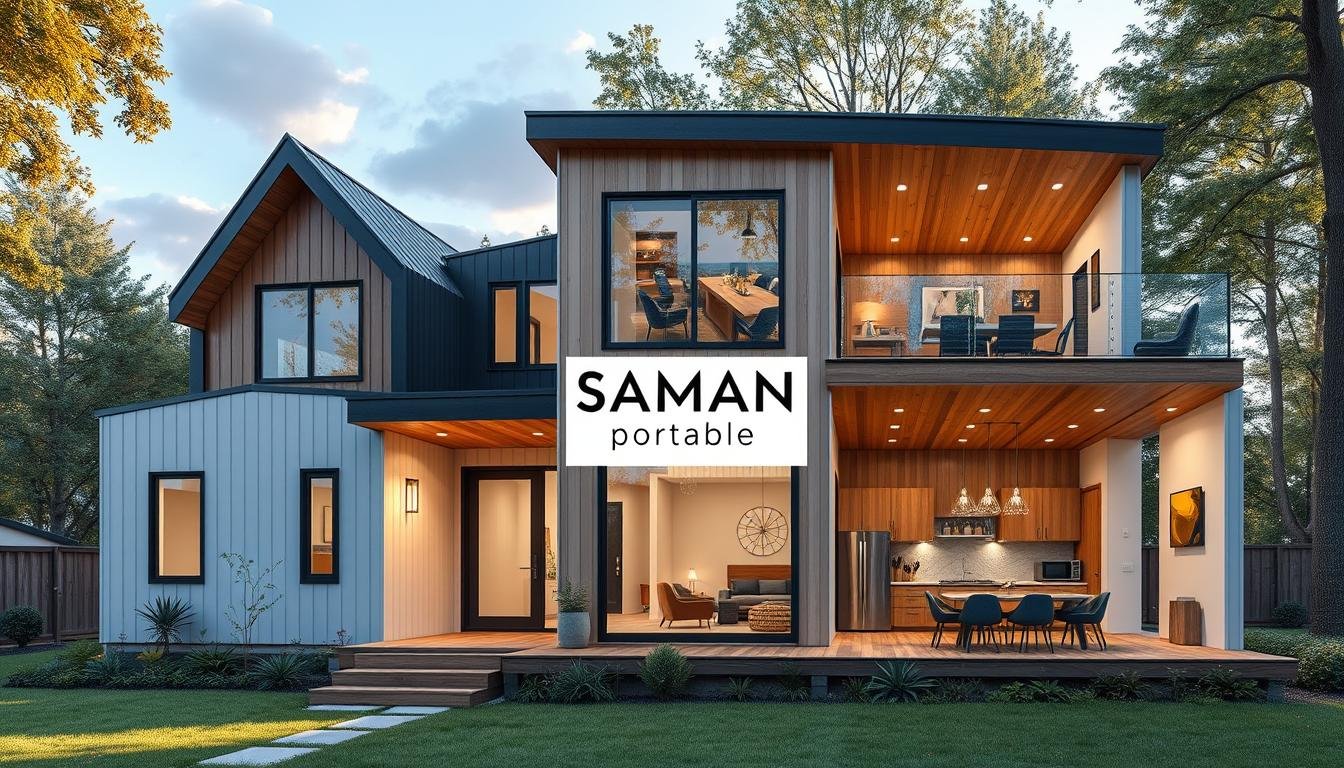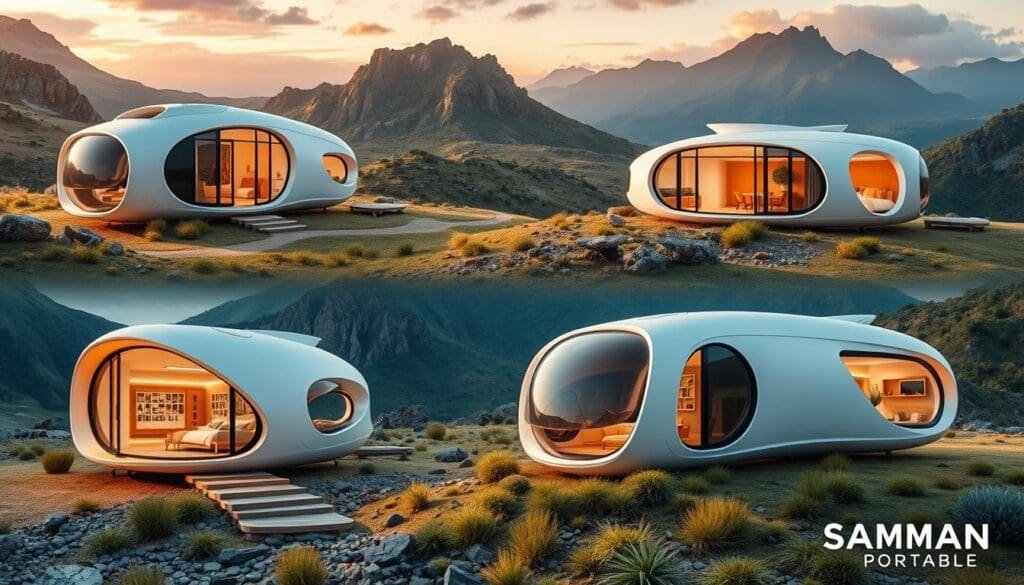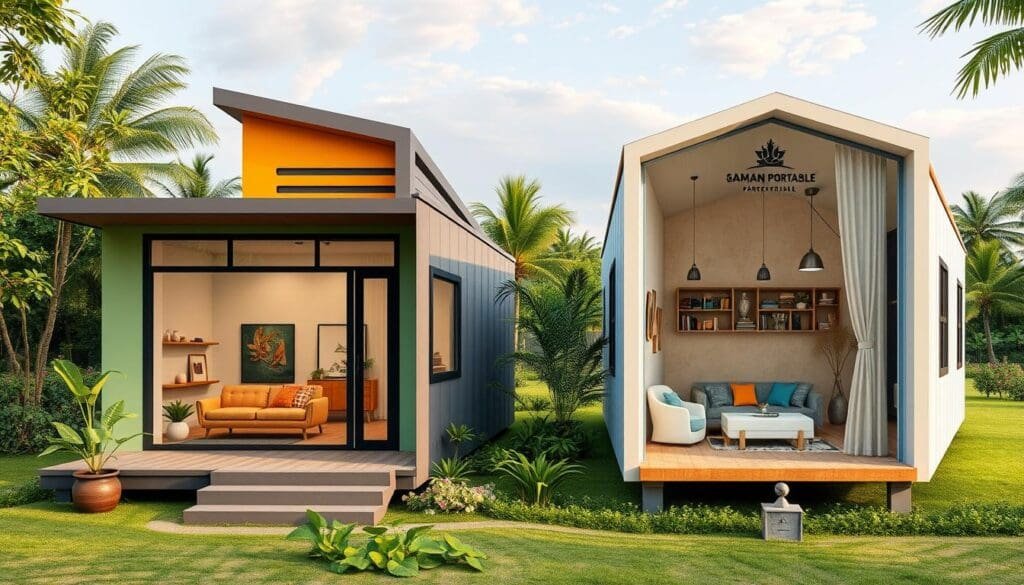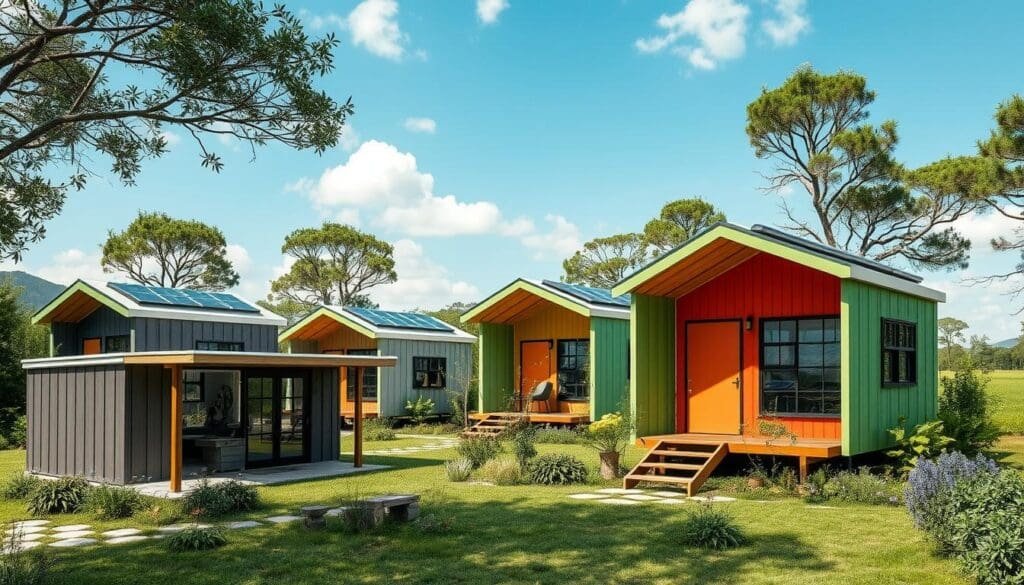Portable Houses for Sale: Customizable, Energy-Efficient & Affordable Prefab Homes

Are you tired of the long, expensive process of building a home? What if you could have a home built quickly, smartly, and sustainably? Portable houses for sale are changing the game in India, bringing new solutions for today’s homeowners.
Prefabricated homes are a big leap forward in building homes. They’re made in factories, ensuring top-notch, custom homes. This means you get a home that fits your needs perfectly.
In India, the demand for portable houses is rising fast. As cities grow and people need homes, these houses offer a smart, affordable, and green option. Whether you want a cozy city home or a big country house, portable houses have you covered.
Key Takeaways
- Portable houses reduce construction time by up to 70%
- Eco-friendly designs can cut energy bills by 30%
- Cost-effective solutions with 10-20% lower pricing compared to traditional homes
- Customizable options to match individual lifestyle needs
- Sustainable construction with 50% reduced carbon footprint
- Advanced technology integration for modern living
Understanding Modern Prefabricated Housing Solutions
The way we build homes has changed a lot with prefabricated homes. Portable buildings are changing how Indians build homes. They offer new ways that challenge old building methods.
Prefab house technology has grown a lot. It uses new manufacturing ways to make good, efficient homes. The industry can now do a lot:
- 80-90% of construction done inside factories
- Projects done half the time of old ways
- Can last over 50 years
Evolution of Factory-Built Construction
Modern prefabricated homes are a big step up from before. Makers have made smart processes. These ensure homes are precise, quality, and fast to set up in India.
Key Components of Modern Prefab Homes
Today’s homes use new tech and materials for lasting and green living. Important parts include:
- Strong materials
- Designs that save energy
- Building in parts
Quality Control Standards
High standards make sure homes are good. Makers check homes a lot. They offer long warranties for the home’s strength and weather protection.
These homes can handle strong winds and heavy rain. They are strong homes for different places in India.
Benefits of Choosing Prefabricated Homes

Prefabricated homes are changing the housing market with their great value and new designs. When you look at mobile tiny homes for sale, you’ll see many benefits that traditional homes can’t offer. These homes are a smart choice for today’s homeowners.
One big plus of prefab homes is how affordable they are. The prices of portable houses are much lower than building a house from scratch. Here are some key benefits of prefabricated homes:
- Substantial cost savings due to streamlined manufacturing processes
- Faster construction timelines
- Reduced material waste
- Enhanced durability against extreme weather conditions
- Flexible design options
Durability is a big plus of prefabricated homes. They are built to last, even in harsh weather. The factory setting means better quality and precision than building on-site.
Energy efficiency is another big benefit. Prefab homes can cut utility costs by up to 40%. This makes them a smart choice for saving money and the environment.
With prices getting better, mobile tiny homes are a great deal for affordable, flexible, and quality housing. They’re perfect for first-time buyers or those wanting to downsize. Prefab homes offer a modern and smart way to live.
Portable Houses for Sale: Market Overview in India
The Indian portable houses market is changing fast. It offers many solutions for today’s housing needs. With over 1000 products on platforms like IndiaMART, finding portable houses for sale is easier than ever for Indian buyers.
Looking at the prices shows a wide range of choices for different budgets and needs:
- Budget-friendly options start at ₹500 per square foot for steel portable houses
- Mid-range portable houses range between ₹800-₹1,200 per square foot
- Luxury prefabricated homes can cost up to ₹1,800 per square foot
Current Market Trends
The Indian prefabricated housing market is growing fast. This is thanks to more people moving to cities and the need for affordable homes. Portable houses are becoming popular because they are built quickly and are cost-effective.
Price Ranges and Options
Prices for portable houses depend on the materials and design:
- Steel Portable Houses: ₹500-₹1,100 per square foot
- Containerized Homes: ₹700-₹1,000 per square foot
- Prefabricated Farm Houses: ₹800-₹1,700 per square foot
Leading Manufacturers
Many innovative manufacturers are leading the portable houses market in India. They offer customizable solutions for homes and businesses. The market is growing, opening up new chances for people looking for flexible and efficient housing.
Design Flexibility and Customization Options
Portable houses have changed home design with new customization options. Today’s mobile tiny homes let buyers create their perfect living spaces. Companies like SAMAN Prefab know that everyone has different needs and tastes.
Customization options for portable houses include:
- Interior layout modifications
- Room configuration adaptations
- Material selection
- Color scheme personalization
- Smart home technology integration
The market now offers a lot of personalization. Over 75% of people want custom layouts in their portable homes. With prices starting at ₹13.4 lakh for 958-1,288 square feet, buyers can make their homes exactly as they want.
Innovative design platforms like SAMANIQ make detailed customization easy. Homeowners can add special areas like home offices, gyms, or multipurpose zones. New manufacturing methods allow for detailed personalization without losing strength or value.
Design flexibility isn’t just about looks. Modern mobile tiny homes can handle tough weather, like 180 Kmph winds and heavy snow. This means your custom portable house will be both stylish and strong.
Energy-Efficient Features and Sustainable Solutions
Portable homes are changing the game for sustainable living. They come with the latest in energy-saving tech. This makes them not only good for the planet but also comfy and cost-effective.
Solar Integration Systems
Today’s portable homes are equipped with top-notch solar systems. These systems can power a whole home, making it energy-independent. The benefits are clear:
- Easy solar panel setup
- Lower electricity bills
- Less carbon emissions
- Big savings over time
Insulation Technologies
Prefab homes lead in keeping warm or cool thanks to advanced insulation. The factory setting lets for perfect placement of top-notch materials. This means:
- Less heat loss
- 20-25% less energy use
- Stable indoor temps
- Less money on heating and cooling
Water Conservation Methods
Sustainable portable homes use smart water-saving tech. They cut down water use with:
- Rainwater harvesting (cuts water use by 50-80%)
- Greywater recycling
- Low-flow appliances
- Smart water management
Choosing a portable home with these features is more than just a smart buy. It’s a step towards a greener future and saves you money in the long run.
Construction Materials and Durability

Portable buildings are changing how we build homes. They use new materials that make them strong and green. This new way of building is better than old methods.
The heart of portable buildings is their top-notch materials. These include:
- High-strength steel composites
- Lightweight insulation panels
- Recyclable and eco-friendly materials
- Weather-resistant structural elements
Pronto’s prefab houses show off amazing engineering. Their roof and wall panels keep heat out like a thick brick wall. Interestingly, Pronto does not use a single bag of traditional cement in their construction processes.
Portable buildings are very durable. Their panels are easy to put together, like Lego blocks. These panels are:
- Extremely weather-resistant
- Maintenance-free
- Available in multiple attractive colors
- Designed for rapid installation
Prefab homes last 30-40% longer than regular houses. Local experts can work with these materials easily. This makes building simple and quick.
Portable buildings use green materials and smart building methods. They are the future of smart, green homes in India.
Smart Home Integration and Technology
Modern prefabricated homes are changing how we live with smart technologies. Whether you’re looking at a portable classroom or a home, these systems are making a big difference. They change how we interact with our living spaces.
Smart home tech is advancing fast, bringing new chances for portable classrooms and homes. People and schools can use these systems to make their spaces better. They improve how things work, keep things safe, and save energy.
Automation Systems
Smart automation systems give us control and ease. Today’s tech lets us manage many home functions with one platform:
- Voice-controlled lighting and temperature management
- Automated scheduling for appliances and systems
- Remote monitoring and control via smartphone applications
Security Features
New security tech offers top-notch protection for homes and classrooms. Key features include:
- Smart lock systems with remote access
- Motion-activated surveillance cameras
- Real-time alerts and monitoring capabilities
Energy Management Solutions
Smart energy systems help save power and protect the environment. They come with:
- Smart thermostats that learn user preferences
- Automated power consumption tracking
- Integration with renewable energy sources
With the market expected to grow to $157 billion by 2024, smart home tech is getting more common. It’s becoming key for modern living, including portable classrooms and prefabricated homes.
Cost Analysis and Financial Planning

Looking into portable houses for sale means understanding the financial side is key. The prices vary a lot, fitting different budgets and tastes.
Important financial points for buyers include:
- Base model pricing starts at INR 650,000
- Luxury portable houses can cost up to INR 5,800,000
- They might save money in the long run because they’re energy-efficient
Buying portable houses can save you money. They cost less to build, with prices from $20 to $50 per square foot. They last at least 20 years, adding to their value.
There are more financial perks:
- They’re built faster, up to 50% quicker
- They cost less to maintain
- They use less energy
- They might get government help for being eco-friendly
There are ways to finance portable houses, like home loans and prefab housing loans. You might also get green energy subsidies. With smart planning, your portable house can be a wise, eco-friendly choice.
Installation Process and Timeline
Investing in portable buildings or modular classrooms means knowing the installation process is key. From site prep to setup, it’s all about planning and doing it right.
The timeline for setting up prefabricated structures is much faster than traditional building. Your project can be done in just a few days to weeks.
Site Preparation Requirements
Starting with site prep is essential for a successful portable building installation. You need to consider:
- Soil stability assessment
- Ground leveling
- Foundation type selection
- Drainage planning
- Utility connection readiness
Assembly Stages
The assembly of portable buildings is structured for speed and accuracy:
- Foundation placement
- Module transportation
- Precise positioning
- Utility connections
- Exterior finishing
Final Inspection Protocol
Quality checks are thorough to ensure your buildings meet safety and performance standards. Inspectors check:
- Structural integrity
- Utility functionality
- Compliance with local building codes
- Overall construction quality
Knowing these steps helps you plan your portable building project well. You’ll have realistic expectations and fewer problems.
Maintenance and Long-Term Care

Maintaining your portable houses needs careful planning and early action. Prefabricated homes are built to last, facing many environmental challenges. With the right care, they can stay in top shape for years.
Here are some important maintenance tips for your prefabricated homes:
- Regular structural inspections
- Protecting innovative materials from environmental stress
- Implementing seasonal care routines
- Monitoring energy-efficient systems
Portable houses need less upkeep than traditional homes. Advanced manufacturing techniques use top-quality materials. These homes can handle strong winds and heavy rain.
Your maintenance checklist should include:
- Quarterly exterior inspections
- Annual system performance evaluations
- Cleaning specialized surfaces
- Checking insulation and weatherproofing
Prefabricated homes can save you up to 50% on long-term maintenance costs. By following the manufacturer’s advice and doing regular checks, you can make your portable house last longer and keep its value high.
Legal Requirements and Building Codes
Buying portable houses for sale means you need to know the law well. It’s important to follow building codes to keep your investment safe and legal.
Zoning Regulations for Portable Buildings
Local laws are key in deciding where you can put portable buildings. Each area has its own rules. These rules affect:
- Land use classifications
- Minimum plot size requirements
- Distance from property boundaries
- Permitted residential zones
Permits and Documentation
Getting the right permits is essential when buying portable houses. You’ll need to gather detailed documents like:
- Site development plans
- Structural engineering reports
- Environmental impact assessments
- Proof of ownership and land rights
Safety Standards Compliance
Prefab homes must meet strict safety standards. Important checks include the building’s strength, electrical setup, and fire safety. Most makers make sure their homes meet or beat national codes.
Knowing these legal points helps you buy and set up your prefab home smoothly. It also helps avoid legal problems.
Eco-Friendly Features and Sustainability
Portable homes are changing the game for sustainable living in India. They use green building materials like bamboo and recycled composites. Natural insulation, such as cellulose and wool, also plays a big role.
The way these homes are made cuts down on waste. Container home construction can reduce waste by up to 25%. This is a big step towards a greener future.
Energy efficiency is key in these homes. They use up to 40% less energy than regular houses. This is thanks to features like double-glazed windows and solar panels.
Homeowners can save a lot of money too. A typical haus.me portable house can save up to $3,600 a year. This makes them a smart choice for those who care about the planet.
These homes do more than just save energy. They also help recycle materials. Shipping container homes can be recycled at a rate of 95%. This means a lot of steel is saved from being thrown away.
As the portable housing market grows, these homes show a new way to live. They are a step towards a more sustainable and responsible lifestyle in India.
FAQ
What are portable houses, and how do they differ from traditional homes?
Portable houses are made in a factory and can be moved to different places. They are built to be easy to set up and are often cheaper and faster to build than traditional homes. These homes use new materials and tech to create high-quality, customizable spaces that can change as needed.
How much do portable houses typically cost?
The price of portable houses varies a lot. Simple tiny homes start at ,000, while bigger, fancier homes can cost 0,000 to 0,000. Prices change based on how custom you want it, the materials used, and if it has smart home tech or saves energy.
Are portable houses durable and safe?
Yes! Modern portable houses are made to last and meet high standards. They use strong materials and are built to handle different weather. They usually come with a warranty that shows they are reliable and safe for a long time.
Can I customize a portable house to match my specific needs?
Yes, you can make a portable house your own. You can change the layout, pick finishes, and choose how it looks outside. You can also add special features like smart home tech or ways to save energy. The makers work with you to make sure your home is both stylish and practical.
What are the environmental benefits of portable houses?
Portable houses are great for the planet. They are made in a controlled factory, which cuts down on waste and pollution. They often use green materials and have tech like solar panels and water savers. They are usually better for the environment than traditional houses and can save a lot of energy over time.
How quickly can a portable house be installed?
Portable houses are fast to set up. They can be ready in weeks, unlike traditional houses that take months. The parts are made in a factory, so there’s less time spent on site. Most portable homes can be moved in and ready to live in in 4-8 weeks.
Are there financing options available for portable houses?
Yes, there are ways to pay for portable houses. Many makers offer financing, and banks are starting to too. There are also government programs for green homes. You can get loans, special prefab home loans, or even rent-to-own options. There might also be tax breaks for homes that save energy.
Can portable houses be used for purposes other than residential living?
Definitely! Portable houses are very flexible. They can be used for schools, offices, worker housing, temporary homes, and even cafes. Their design and quick setup make them perfect for many uses where you need to be flexible and fast.
 Container Cafe
Container Cafe



























































































